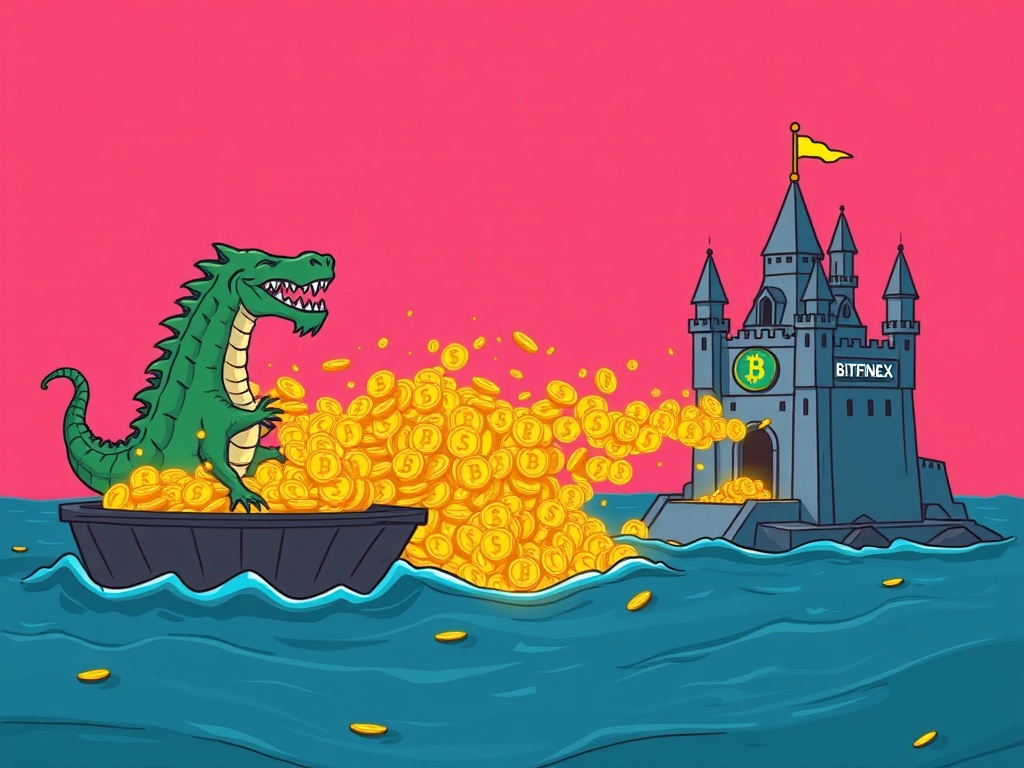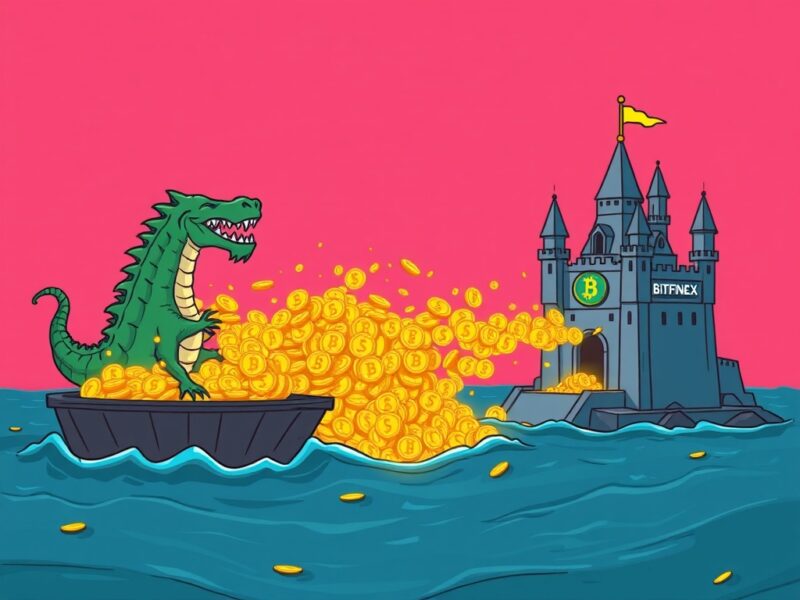BitcoinWorld

Massive USDT Transfer: Unpacking the $210 Million Kraken to Bitfinex Shift
The cryptocurrency world is always abuzz with activity, but every so often, a transaction occurs that truly captures attention. Recently, the digital realm witnessed such an event: a Whale Alert report confirming a staggering 210,000,000 USDT transfer from the Kraken exchange to Bitfinex. Valued at approximately $210 million, this massive movement of Tether’s stablecoin has naturally sparked curiosity and discussion across the crypto community. What prompts such a colossal shift of funds, and what could it mean for the broader market? Let’s dive deep into the implications of this significant USDT transfer.
What Exactly Happened with This Massive USDT Transfer?
On [Insert Date of Transaction if known, otherwise use ‘a recent date’], the blockchain tracking service Whale Alert reported a colossal transaction that sent ripples through the crypto space. A sum of 210 million Tether (USDT), the world’s largest stablecoin by market capitalization, was moved from Kraken, a prominent U.S.-based cryptocurrency exchange, to Bitfinex, another major global exchange. This substantial USDT transfer, equivalent to approximately $210 million, immediately caught the eye of market observers and analysts. Such large movements of funds, often termed ‘whale transactions,’ are typically indicative of significant underlying activities that can influence market dynamics.
To put the scale into perspective:
- Amount: 210,000,000 USDT
- Value: Approximately $210,000,000 USD
- Origin: Kraken Exchange
- Destination: Bitfinex Exchange
- Reported by: Whale Alert
While the immediate reason for this particular USDT transfer isn’t publicly disclosed, its sheer size warrants a closer look into the potential motivations and broader market ramifications.
Why Do Such Large USDT Transfers Occur? Unpacking Whale Motives
When a crypto ‘whale’ — an individual or entity holding a substantial amount of cryptocurrency — executes a large USDT transfer, it’s rarely a random act. There are several strategic reasons behind such significant movements, often aimed at optimizing positions or capitalizing on market conditions. Understanding these motives is crucial for interpreting the potential impact of such a transaction.
Common reasons for large stablecoin transfers include:
- Arbitrage Opportunities: Price discrepancies for cryptocurrencies often exist between different exchanges. A whale might move a large sum of USDT to an exchange where a specific asset (like Bitcoin or Ethereum) is trading at a lower price, allowing them to buy low and sell high on another exchange, thereby profiting from the difference. This rapid USDT transfer facilitates quick execution.
- Liquidity Management: Exchanges themselves, or large institutional traders, frequently move funds between their own hot and cold wallets, or between different exchange platforms, to manage liquidity. This ensures they have enough funds readily available to meet withdrawal demands or facilitate large trades without impacting market stability on a single platform.
- Over-the-Counter (OTC) Deals: For transactions of this magnitude, whales often prefer OTC desks to avoid slippage (price changes due to large orders) on public exchanges. They might transfer USDT to an exchange’s OTC desk or a dedicated OTC platform to execute a private deal for a large block of cryptocurrency.
- Preparation for Large Trades: A whale might be accumulating or preparing to sell a significant amount of another cryptocurrency. Moving USDT to an exchange could indicate an intent to buy, while moving it off an exchange might suggest a large sale is imminent via an OTC desk or private transaction.
- Security and Custody: While less common for transfers between exchanges, some large holders might move funds for security reasons, consolidating assets or transferring them to a more secure cold storage solution. However, a transfer between two active exchanges usually points to transactional intent.
It’s important to note that without direct confirmation from the parties involved, any interpretation of a large USDT transfer remains speculative. However, by considering these common motives, we can better gauge the potential implications.
Kraken vs. Bitfinex: Key Players in the USDT Transfer Saga
The choice of exchanges involved in a large USDT transfer can sometimes offer additional clues about the nature of the transaction. In this case, the movement occurred between Kraken and Bitfinex, both established and significant players in the global cryptocurrency landscape.
| Exchange | Key Characteristics | Role in Crypto Ecosystem |
|---|---|---|
| Kraken |
|
A major fiat-to-crypto gateway, particularly strong in North America and Europe. Attracts both retail and institutional traders seeking regulated and secure trading environments. |
| Bitfinex |
|
A preferred platform for professional traders and institutions due to its deep order books and sophisticated tools. Its historical connection with Tether makes it a key hub for USDT activity. |
The fact that this USDT transfer happened from Kraken to Bitfinex could suggest a few things:
- Access to Liquidity: Bitfinex is renowned for its deep liquidity, especially for USDT and major crypto pairs. A whale might be moving funds to Bitfinex to execute a very large trade that requires minimal price impact.
- Tether’s Primary Hub: Given Bitfinex’s historical and ongoing close relationship with Tether, it often serves as a primary hub for large USDT operations, including issuance, redemption, and significant transfers.
- Geographical or Regulatory Reasons: While less likely for a simple transfer, different regulatory environments or operational preferences could play a role in why funds are shifted between exchanges.
The Potential Ripple Effects of a Major USDT Transfer on the Market
A 210 million USDT transfer is significant enough to warrant consideration of its potential impact on the broader cryptocurrency market. While a stablecoin transfer doesn’t directly alter the supply of volatile assets like Bitcoin or Ethereum, it can signal shifts in sentiment, liquidity, and trading strategies.
Impact on USDT and Stablecoin Dynamics:
- Liquidity Shift: Moving such a large sum of USDT from one exchange to another redistributes liquidity. If it moves to an exchange with less existing USDT, it could increase the available liquidity there for trading pairs involving USDT.
- Demand Signal: A large inflow of USDT to an exchange could signal an increased demand for stablecoins on that platform, potentially indicating an intent to purchase other cryptocurrencies, or perhaps a large-scale redemption.
- Confidence in Tether: The continuous large-scale movement of USDT across exchanges generally reinforces confidence in Tether’s ability to handle significant transactions and maintain its peg, even amidst large transfers.
Broader Market Sentiment and Price Action:
While a USDT transfer itself doesn’t directly cause price movements, it can be a precursor to them. For example:
- Potential Buying Pressure: If the USDT is moved to an exchange to buy other cryptocurrencies, it could signal impending buying pressure, potentially leading to upward price movements for assets like Bitcoin or Ethereum.
- Potential Selling Pressure: Conversely, if the USDT is being moved off an exchange to facilitate an OTC deal for a large sale of crypto, it might indirectly indicate future selling pressure, though this is less common for stablecoin inflows to an exchange.
- Market Speculation: Large whale movements often lead to speculation. Traders and algorithms monitor these transactions closely, and the perceived intent behind them can influence short-term market sentiment, creating volatility.
It’s crucial to distinguish between a stablecoin transfer and a transfer of volatile assets. A Bitcoin transfer directly affects Bitcoin’s supply on exchanges, whereas a USDT transfer primarily affects liquidity and potential trading intentions.
How Can You Track and Interpret USDT Transfers? Actionable Insights
For those looking to gain a deeper understanding of market movements and potentially anticipate trends, tracking large USDT transfer events can be an invaluable tool. While it’s not a foolproof crystal ball, it provides critical insights into the activities of major market players.
Tools for Tracking Whale Activity:
- Whale Alert: As seen with this transaction, Whale Alert is a popular and effective service that automatically tweets large cryptocurrency transactions across various blockchains. Following their feed is a good starting point.
- Blockchain Explorers: For a more granular view, you can use blockchain explorers like Etherscan (for ERC-20 USDT) or Tronscan (for TRC-20 USDT). By pasting transaction IDs or wallet addresses, you can see the exact details of a USDT transfer, including timestamps, amounts, and involved addresses.
- On-Chain Analytics Platforms: Services like Glassnode, CryptoQuant, or Santiment offer more sophisticated on-chain data and analytics, often presenting whale movements in aggregated, digestible formats with historical context. These platforms can help identify trends in USDT transfer patterns.
Interpreting the Data:
When you observe a large USDT transfer, consider the following:
- Origin and Destination: Is it moving from an exchange to a private wallet (potential accumulation/holding)? From a private wallet to an exchange (potential selling/trading)? Or between exchanges (arbitrage, liquidity, OTC)?
- Frequency and Volume: Is this an isolated event, or part of a series of large transfers? Consistent large movements can indicate a sustained strategy.
- Market Context: What is the overall market sentiment? Are prices rallying or declining? A large USDT transfer might have different implications in a bull market versus a bear market.
Actionable Insight: While tracking whale movements can be insightful, it’s vital to avoid making impulsive trading decisions based solely on a single transaction. Always combine this information with broader market analysis, technical indicators, and fundamental research. Think of it as one piece of a larger puzzle, not the entire picture.
Navigating the Challenges and Opportunities of Large USDT Transfers
Large USDT transfer events, while fascinating, come with both challenges and opportunities for the average crypto participant. Understanding these can help you navigate the often-volatile crypto waters more effectively.
Challenges:
- Information Asymmetry: Whales have access to information and resources that the average retail investor does not. Their moves are often based on private deals or deep market insights, making it difficult to fully understand their intentions.
- Market Noise and FUD: Significant transactions can quickly generate rumors and Fear, Uncertainty, and Doubt (FUD), leading to unnecessary panic or irrational trading decisions among less informed investors.
- Misinterpretation Risk: As discussed, a large USDT transfer can have multiple interpretations. Misreading the intent behind such a move can lead to poor investment choices.
Opportunities:
- Learning and Analysis: Tracking these transfers provides an excellent opportunity to learn about market dynamics, liquidity flows, and the behavior of large entities. It enhances your understanding of how the crypto ecosystem functions.
- Anticipating Potential Shifts: While not a direct signal, consistent large USDT transfer patterns to or from exchanges can sometimes precede significant price movements, offering a chance for informed anticipation.
- Reinforcing Due Diligence: Observing such transfers encourages deeper dives into the fundamentals of stablecoins and the operational aspects of exchanges, fostering a more robust investment strategy.
Conclusion: The Enduring Significance of the USDT Transfer
The recent 210,000,000 USDT transfer from Kraken to Bitfinex serves as a powerful reminder of the dynamic and often opaque nature of the cryptocurrency markets. While the exact motivations behind this specific transaction remain unconfirmed, it underscores the constant movement of significant capital within the digital economy. Whether it was for arbitrage, liquidity management, or an OTC deal, such a substantial USDT transfer highlights the critical role stablecoins play in facilitating large-scale operations and influencing market sentiment.
For investors and enthusiasts, these whale movements are not just curiosities; they are signals. By carefully observing and analyzing them within the broader market context, one can gain valuable insights into potential shifts in supply and demand, liquidity, and even the strategic positioning of major players. As the crypto landscape continues to evolve, staying informed about these colossal transfers will remain a key aspect of navigating its complexities and making more informed decisions.
Frequently Asked Questions (FAQs)
Q1: What is USDT (Tether)?
A: USDT, or Tether, is the largest stablecoin by market capitalization. It is designed to maintain a stable value, pegged 1:1 to the US dollar. This stability makes it a popular medium for trading cryptocurrencies, as it allows traders to move in and out of volatile assets without converting back to traditional fiat currency.
Q2: What is a crypto ‘whale’?
A: A crypto ‘whale’ is an individual or entity that holds a very large amount of a particular cryptocurrency. Their transactions, due to their sheer size, have the potential to significantly influence market prices and liquidity, making their movements closely watched by the wider crypto community.
Q3: Does a large USDT transfer always mean a market pump or dump?
A: Not necessarily. While a large USDT transfer can precede significant price action (e.g., if USDT is moved to an exchange to buy Bitcoin, potentially causing a pump), it can also be for liquidity management, OTC deals, or arbitrage, which may not directly or immediately impact broader market prices. It’s a signal, not a definitive prediction.
Q4: How reliable are Whale Alert reports for tracking a USDT transfer?
A: Whale Alert is highly reliable for reporting large, publicly verifiable transactions on the blockchain. They track movements across various cryptocurrencies and stablecoins, providing real-time updates. However, they report the transaction itself, not the underlying motive, which requires further analysis.
Q5: Is this specific 210 million USDT transfer unusual?
A: While 210 million USDT is a substantial sum, transfers of this magnitude, or even larger, are not uncommon in the cryptocurrency space, especially involving stablecoins. Whales and institutional players regularly move large sums for various strategic reasons, making such a USDT transfer part of the normal, albeit significant, flow of the market.
Q6: What should I do if I see a large USDT transfer reported?
A: The best approach is to use it as an informational data point, not a direct trading signal. Consider the context (e.g., origin, destination, overall market conditions). Avoid panic or impulsive decisions. Instead, use such reports to deepen your understanding of market dynamics and liquidity flows, complementing your broader research and investment strategy.
Did you find this analysis of the massive USDT transfer insightful? Share this article with your friends and fellow crypto enthusiasts on social media to help them understand the fascinating world of crypto whale movements and stablecoin dynamics!
To learn more about the latest crypto market trends, explore our article on key developments shaping Bitcoin price action.
This post Massive USDT Transfer: Unpacking the $210 Million Kraken to Bitfinex Shift first appeared on BitcoinWorld and is written by Editorial Team





